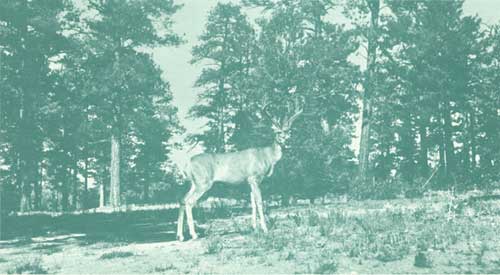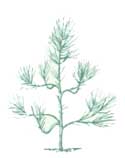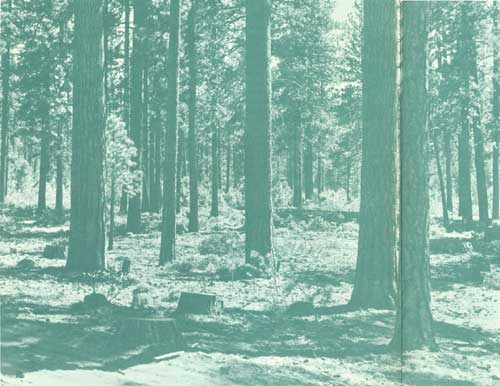|
TREES OF THE FOREST: Their Beauty and Use |

|
The Balances of Management
Throughout the 182 million acres of the National Forests other important factors are weighed in the balance with the need to produce timber. They may be the reason for heavy cutting, light cutting, or no cutting.
Wildlife, for example, has become increasingly dependent upon the National Forests. Almost everywhere the land available to it has been reduced through the spread of towns, cities, industries, and highways. It is estimated that the native American forest once covered more than 900 million acres, with extensive borders and many open places where grass, plants, and herbs grew and served as food for deer, elk, wild turkey, and other animals and birds. In our modern managed forests, clear cutting and heavy selection cutting make more food available to animals and birds by opening clearings and creating edges.

|
| F-451938 |
On the other hand, fish are benefited by not harvesting timber along the streamside. The forest canopy provides shade and a favorably cool temperature. Insects fall in the water from overhanging branches, providing food. Roots of trees and shrubs bind the soil, holding banks in place, affording sheltered retreats along the streamside.
A vital factor in balanced management is the need to protect the forest as a natural reservoir of water. Uncontrolled logging and fire can strip the land of its porous cover, leaving it unable to absorb water. The disastrous consequences are soil erosion, flash floods, and muddy streams. Thus, as soil conditions require, the forester may plan light to moderate selection cuttings. Or in other cases, as in the Southwest where virgin timber grows amid a dense understory of young growth and water is in short supply for a growing population, he may consider heavy thinnings to replace deep-rooted trees with grasses and broadleaf herbs, making more water available for human use.

In campgrounds and picnic areas, recreation values are protected by limiting cutting to dead, dying, and diseased trees. In natural areas, old trees and surrounding vegetation are subject only to minimum management so that visitors may read living history as written on the land. In wilderness and wild areas, timber cutting is not allowed. Those primitive lands, 14-1/2 million acres in all, have been dedicated by the Forest Service to wilderness use and are protected in their natural state for those who enjoy extensive foot or horseback travel in serenity and solitude.
Each forest resource and each of the many uses of resources is needed in the pattern of a growing Nation. Each is accorded its place in balancing National Forest plans of management.

|
| F-437462 |
| <<< Previous | <<< Contents>>> | Next >>> |
|
PA-613/sec3.htm Last Updated: 12-Sep-2011 |